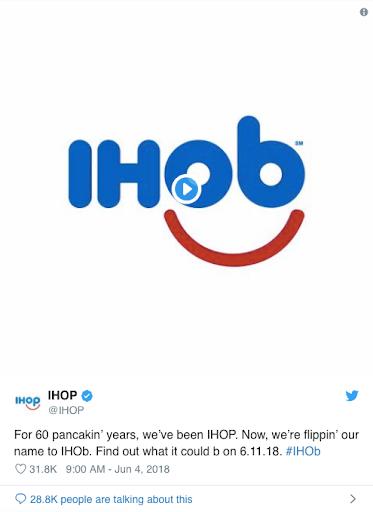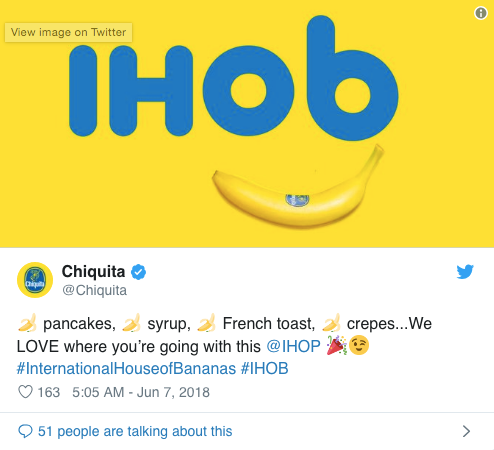How to rebrand to change your brand positioning
How to rebrand to change your brand positioning
- IHOP rebrands as IHOb
- How to change your brand's positioning through a rebrand
- Key takeaways
The International House of Pancakes (IHOP) has had hamburgers on its menu since it opened its doors on Riverside Drive in Burbank, California in the summer of 1958. But nearly as steady as the flow of pancakes making their way out of IHOP's kitchens was a series of failed attempts to grow the chain's lunch and dinner businesses. Despite being open 24/7, more than half of IHOP's revenue comes from breakfast, with dinner generating merely 16% of the company's earnings.
As IHOP President Darren Rebelez and his team considered this problem, it was obvious to them that the company's name was responsible for its positioning in the market: IHOP had understandably become synonymous with pancakes. A new line of black angus burgers was being introduced at IHOPs around the globe, but Rebelez knew that he was heading toward another failed attempt to grow IHOP's lunch and dinner business — unless he could change his brand's position in the market.
"We knew if we were going to really get into the burger business in a meaningful way that we were going to have to do something bold and creative," Rebelez said. In the summer of 2018, they did just that.
IHOP rebrands as IHOb
Rebelez's plan began on June 4, 2018, when IHOP's corporate Twitter account sent out a tweet hinting that the company would soon be changing its name to IHOb. "We came up with the idea of flipping the 'p' to a 'b' to really grab everyone's attention," said Rebelez.

A social media firestorm ensued, as IHOP fans wondered aloud what the newly introduced "b" stood for. "Breakfast" was the obvious answer — such a move could easily reposition the company to offer a wider array of breakfast items aside from just pancakes. Bacon? Biscuits? The ambiguity of it all was maddening, and countless other brands jumped on the conjecture bandwagon.

One week later, IHOP made the name change official: IHOP was now IHOb, and the "b" stood for burgers. Not everybody was amused, but the results of the change were undeniable: the campaign generated over 30 billion social media impressions and 20,000 news articles. According to YouGov, which tracks the perception of more than 1,500 brands daily through its BrandIndex, IHOP's Word of Mouth score rose from 19 percent to 30 percent in the week following its announcement.

Then, just one month after announcing the name change, IHOP shocked the world again when it announced that the name change had been nothing more than a publicity stunt to promote its burger business; the company was reverting to being called IHOP once again. While the "rebrand" was technically a hoax, the story perfectly illustrates the power of rebranding to change your positioning in the market. IHOP's burger sales quadrupled in the subsequent quarter.
Let's explore how brand managers can use a rebrand to change their positioning in the market — like IHOP, but without the hoax.
How to change your brand's positioning through a rebrand
Repositioning a brand is a major undertaking and can mean anything from expanding people's perceptions of you brand — as IHOP did — to changing their perceptions altogether. There are plenty of reasons that you may need to rebrand to change your brand's positioning, but let's explore a few of the most common.
Common reasons brands need to change their positioning
- The brand has changed its focus or direction. Often this occurs as single-product brands grow and introduce additional products; a rebrand is required to better encompass all of the company's products.
- The brand needs to alter or improve its public perception. Brands that have fallen on hard times or suffered from tarnished reputations often rebrand with the goal of improving public perception of their brand. Uber recently did so in the face of workplace harassment and discrimination charges. Uber's moving forward and diversity pages are examples of this rebrand in action. They even released a TV spot using the video at the top of their moving forward page.
- The market has become increasingly competitive, and the brand needs to evolve to distinguish itself from the competition. Copper, a CRM software company, recently rebranded for this reason. Formerly called ProsperWorks, Copper competes in a hyper-competitive category that's long been dominated by the color blue and companies with very literal names; for example, Salesforce, SugarCRM, and Salesloft. By adopting a less literal name and magenta (a shade of bright pink) as their brand's primary color, Copper sought to distinguish its brand in an increasingly homogenous market.
- The brand is struggling to remain relevant as market or consumer preferences change. Faced with a younger generation of customers who are more health conscious, Dunkin' Donuts recently rebranded to Dunkin' in an effort to shed the perception that all the brand offers is donuts. Without doing so, the brand feared it would lose relevance and the brand loyalty of its younger customers.
Regardless of your reasons for considering a rebrand, your customers' perceptions of your brand are your brand's reality. Any successful rebrand starts with carefully analyzing what those existing perceptions are. How? Through customer research.
Start with customer research
Businesses can't change consumer perceptions of their brand — or their positioning in the market — until they identify what those perceptions are. "Marketing is not about merely sharing what you, the marketer believes," says bestselling marketing author Seth Godin. "It's about what we, the listener, believe." Follow the steps outlined below to begin understanding the existing perceptions of your brand.
How to perform customer research on your brand perception
- Start with social—Social media interactions can be a useful place to start capturing insights into consumer perceptions of your brand. You can start by simply scrolling through your social media feeds looking for mentions of your brand. Keep an eye out for both praise and criticism, as it's typically emotional responses to your brand that will surface useful insights. Also look at any online reviews of your product or service. Social media monitoring tools like Google Alerts or Mention.com can be helpful in consistently surfacing new brand mentions that occur online.
- Interview your customers—Use surveys or interviews to ask your customers open-ended, leading questions about your brand. Ask them questions like:
- What perceptions do you have of our brand?
- What values do you associate with our brand?
- What values are important to you as a consumer?
- If you could change one thing about your experience with our brand, what would it be?
- Empathize with your customer—Now that you know what your customers think about your brand, you must uncover why they think that way. Ask them directly what's led them to their perceptions of your brand.
- Talk to your frontline employees—Include as many frontline employees as possible in the customer research process; they are the ambassadors of your brand on a day-to-day basis. "I think the biggest mistake people make when they do a rebrand is they don't involve enough people internally," says Morgan Norman, CMO of Copper.
- Document and share your findings—Your brand perception ultimately starts with your own internal team, and your rebrand won't be successful without them. It's critical that you document and share your findings openly, so that your team understands why a change in positioning is necessary.
While performing customer research may feel time consuming, it's the foundation that your rebrand will be built upon. "Sometimes one sentence said by one person within hundreds of hours of conversation unlocks a powerful new idea," says Peter Muhlmann, CEO & Founder of online reviews site Trustpilot. To illustrate the importance, let's take a look at two brands that failed to take this critical step.
Two brands that moved too fast: Netflix and Overstock.com
In 2011, online retailer Overstock.com decided to rebrand, starting with a change to their company name. But the company made a critical misstep, failing to conduct ample customer research and instead hinging their rebrand on a desire to be more "hip."
After unveiling a new brand name — O.co — the company proceeded to update its website, its advertising, everything. It even changed the name of the NFL stadium in Oakland for which it owned naming rights. The brand name fell flat with consumers, many of whom were confused and navigated to 0.com rather than O.co after seeing the company's new commercials. "We were going too fast and people were confused, which told us we didn't do a good job," President Jonathan Johnson said.
Netflix, the online service for streaming digital TV shows and movies, made an even grander blunder that same year after failing to gather sufficient customer feedback to inform their rebranding project. The company decided to rebrand its DVD rental business as Qwikster, a move it would retract only a few weeks later after 800,000 customers canceled their subscriptions. "I messed up," said CEO Reed Hastings. "It's clear from our research over the last two months and we owe our customers an explanation."
Only once you have a solid grasp on consumers' perceptions of your brand can you begin the process of repositioning so that it better resonates with your target customers. "It is incredibly powerful to tell your customer, 'We have listened to you, and we are going to do things a little differently now,'" says Anurag Harsh, SVP and Founding Executive of Ziff Davis.
Maintain the core, favorable attributes of your brand; toss the rest
With your customer research in hand, it's time to make some decisions: What's the overarching objective of your rebrand? What positioning in the market do you want your new brand to lay claim to?
Peter Muhlmann, CEO of Trustpilot, recently faced these decisions as he sought to reposition his brand to support international expansion and combat a growing distrust of online review sites. "In the end, we re-discovered our core by highlighting all of the good and tossing what needed to be changed," said Muhlmann.
This is a common thread in most rebranding projects. Your brand, regardless of its state, holds onto some undeniable truths that will likely always be core elements of its brand identity. The key is to maintain these elements while discarding the perceptions that are unfavorable, too narrow, or no longer relevant. These questions can help you identify and make decisions about the positioning your rebrand aims to support.
Questions to inform your new brand position
- Why do we exist? This question helps you define your organization's reason for being aside from just making profits. It's important that you dig into your brand's purpose and values first, so that when you get to the details like designing a logo and choosing a typeface, you have a better idea of what you are trying to express.
- Can we lead the world in what we do? The most favorable positioning for your brand is likely the one that you can claim more than anyone else. This question helps you dig into your company's core competencies; strive to identify a brand position your company can fight for and win.
- What attributes of our product or service are differentiated from competitive products? In what ways is your brand differentiated from your competitors? You need to identify these attributes before you can decide which ones to hinge your positioning on.
- What attributes of our product or service do (enough) target consumers care about? Your brand may be differentiated on attributes that simply aren't important to prospective buyers. The key is to identify points of differentiation that matter to at least some segment of target customers. Not all target customers, but some specific group. Identify the group that cares about your points of differentiation, and use that to your advantage.
- Where is the "white space"? Particularly in crowded markets, seek to identify the "white space" — the corners of your market that nobody is fighting for.
As you go through the process of answering these questions, an agency partner can often provide an enormous amount of value. It's not that your own internal team is lacking in knowledge or skill, but more that an agency can hold up an unbiased mirror to your business.
Let's next look at a brand with a particularly challenging product that successfully rebranded to dramatically change their position in the market.
Kellogg's rebrands All-Bran around its cancer fighting superpowers
When Bill Weintraub took the reigns as CMO at Kellogg's, he inherited a particularly challenging brand with lagging sales: All-Bran cereal.

Kids would fly by the box in the grocery store in search of Froot Loops or Frosted Flakes, and even for the most health-conscious consumers, All-Bran was a tough sell.
"In the case of All-Bran cereal, it's not very appetizing," says Weintraub. "It's not appetizing-looking and it gets very soggy. It tastes like you're eating straw."
Weintraub knew that he'd need to reposition the brand in order to successfully turn sales around, a process that began with carefully considering the existing characteristics and truths of the product. Weintraub noted that All-Bran had more dietary fiber than not just any cereal, but any food on the market. Otherwise, the product wasn't exactly ripe with attributes that could be used to reposition the brand. "The only other possible benefit that this brand has is it helps you if you're constipated; and that's not something easy to talk about or discuss," Weintraub said.
Dietary fiber it was.
Until that time, food brands in the United States were not allowed to make health claims without going through a prohibitively expensive and time-consuming process that included clinical trials and getting formal approval from the Food and Drug Administration (FDA). Weintraub saw an opportunity to circumvent the FDA and position All-Bran around the benefits of a diet that's high in dietary fiber — namely cancer prevention.
"All-Bran had more dietary fiber than any food," says Weintraub. "The National Cancer Institute, who is a government agency, doesn't give a shit about brands, but they do have an interest in preventing cancer. And a diet that is rich in dietary fiber reduces the risk of certain kinds of cancer, so the National Cancer Institute said, 'We will support your brand, and we will endorse your brand.' So the Food and Drug Administration was not happy that we did this with a different branch of the federal government. But there's nothing they could do to stop this, because the National Cancer Institute was interested in preventing cancer, and so we went ahead."
In doing so, All-Bran became the first food product in the United States to successfully make a health claim — one that resonated deeply with health-conscious consumers and turned sales of the product around. The dietary fiber had been present in All-Bran all along, but it took the cancer prevention claims to successfully reposition the product.
Next, we'll look at a shift that many modern brands are making in order to command a premium price, increase brand loyalty, and accelerate the speed at which their brands claim a new position in the market.
Move from a purchase brand to a usage brand
Once you've identified the attributes of your brand that you'd like to exploit, you should carefully consider the strategies you'll use to bring your new brand positioning to market. Mark Bonchek and Vivek Bapat make a compelling case for a strategy they describe as moving from a purchase brand to a usage brand in their article "The Most Successful Brands Focus On Users Not Buyers," published in Harvard Business Review.
Bonchek and Bapat surveyed consumers about their perception, usage, preference, and advocacy for 50 different brands, the responses resulting in two clusters the authors refer to as purchase brands and usage brands. The differences lie in the approach these brands take to positioning their products in the market.
Purchase brands worry about what they say to customers; usage brands worry about what customers say to each other. Purchase brands try to create differentiation in brand perception in the hope it will influence consideration and purchase. But usage brands are focused on how their products will make a customer's life better.
The role of advertising, then, becomes very different. While purchase brands leverage advertising in hopes that consumers will consider buying their products, usage brands use advertising as a means of getting useful content and experiences into the hands of prospective customers. The message for usage brands shifts to "Look at how easy, great, or convenient our brand is making your life — imagine what it will be like when you become a customer of ours."
Take for example Sephora, a retailer of makeup and other cosmetic products. Sephora's sales model relies heavily on the in-store experience, where the company focuses on educating consumers about various makeup products, giving in-store demonstrations, and even teaching potential customers how to apply each product properly. Before a purchase is ever made, the in-store experience educates the buyer, teaching them something new. At that point, it's only logical that a potential customer looking to purchase makeup would buy the product that they were taught specifically to apply. Cosmetic stores that rely on glossy magazine advertisements showing models wearing makeup products are not able to reap similar benefits.
Here's how you can help transition your brand from a purchase brand to a usage brand.
How to transition from a purchase brand to a usage brand
- Focus less on what your advertising says, more on what your customers do.
Influencer marketing, user-generated content, and referral programs represent opportunities for your customers to help change your brand positioning for you. The words and opinions of actual customers are typically viewed as more credible and trustworthy than those of brands themselves; leverage your existing customers to your advantage. - Create great brand experiences, even for non-customers.
As we saw with Sephora, focus on creating great content and brand experiences for non-customers. Doing so allows you to build brand credibility, so when the time for a purchase presents itself, your brand is top-of-mind for the consumer.
The benefits of making the transition from a purchase brand to a usage brand are reinforced by Bonchek and Bapat's survey findings. On average, customers of usage brands were willing to pay a 7% premium, were 8% less likely to switch, and were more than twice as likely to make a spontaneous recommendation of the brand.
Launch your new brand
With your new position in the market identified and your strategy taking form, it's time to launch and take your rebrand to market. Here are four important strategies to leverage to make sure your new brand lands effectively and begins to take hold.
- Make a big splash. Rebranding to change consumer perception of your brand is hard. You'll never be able to permanently delete your customers' memories or past experiences with your brand; you can only hope to change their perceptions going forward. Changes in perception don't happen with small incremental tweaks, so make a big splash when you launch your new brand. Remember IHOP? Faux name change or not, the company's "rebrand" was successful largely because they dared to be bold.
- Launch the new brand in conjunction with another significant milestone or event. Launching your new brand in conjunction with another major milestone offers a few benefits. First, it provides another newsworthy reason to shine light on your brand and often draws in a new audience who cares about that event or milestone. Additionally, it take the focus off of the rebrand, helping to ensure that the rebrand isn't being viewed as "a rebrand for the sake of a rebrand." For example, IHOP launched its new brand alongside a partnership with DoorDash, announcing that the company would deliver either burgers or pancakes. "I always believe in launching around an event," says Morgan Norman, whose rebrand of Copper launched at Google's Next conference. "It makes it real for people and real for customers."
- Build a cross-departmental team. A rebrand is not simply a marketing project. Delivering your new brand requires a cross-functional team that includes resources from all parts of the organization. You may need your legal team involved if you're changing your brand name, you'll need customer service to help update service messages, and your sales team will need to communicate with prospects to explain why the rebrand is happening and how it's beneficial to them. If your employees don't buy into the rebrand, your customers never will.
- Stay the course, closely adhering to your new brand guidelines. It's exceedingly rare that any rebrand occurs without some form of confusion or criticism; prepare yourself for this ahead of time and trust in the process that you've followed. Continue to adhere to your new brand guidelines in everything that you do. IHOP's rebrand, while short-lived, went so far as replacing signage for stores in highly visible locations like Hollywood, California, even though the company knew the rebrand would be reversed.

Rebranding to change a brand's positioning in the market is a challenging task for even the most experienced brand marketers, but sometimes it's the only path forward. By conducting in-depth customer research, maintaining the favorable aspects of your brand, and mobilizing your customers to help bring your new brand position to market, you can effectively reposition your brand to achieve the business results you're looking for.
Key takeaways
- Many rebrands fail in their efforts to change the brand's positioning because they are too busy saying what they want to say, not what the audience wants to hear. Customer research will help you avoid most rebranding pitfalls.
- Maintain the core, favorable attributes of your brand, but drop the aspects of your current positioning that are no longer relevant or favorable for your brand.
- Strive to move from a purchase brand to a usage brand. Your customers represent your biggest ally in quickly and effectively changing perceptions of your brand.
- Make a big splash when launching your new brand. Changing consumer perceptions is hard — be bold!